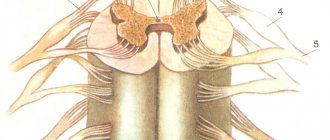Physics lesson notes with presentation, 9th grade. Mechanical vibrations
Plan - summary of an open lesson in physics in the 9th grade
Author of the work: Natalya Viktorovna Kurilova, MBOU Secondary School No. 40 named after Hero of the Soviet Union Ivan Ivanovich Smolyanykh, Novoshakhtinsk, Rostov region.
Plan - summary of an open lesson in physics in 9th grade
Lesson topic: “Study of the dependence of the period and frequency of oscillations of a mathematical pendulum on various physical quantities.”
Subject:
physics.
Class:
9.
Topic studied:
“Oscillations and waves”, lesson No. 9.
Basic textbook:
A.V.Peryshkin, E.M.Gutnik “Physics, 9th grade”, ed.
“Bustard”, 2010. Lesson type:
laboratory workshop.
Lesson form:
research work.
Teaching methods:
visual, reproductive, practical work in groups, frontal questioning, interactive testing.
Forms of organizing educational activities:
group, frontal.
Planned results:
experimentally verify that the period and frequency of oscillations of a mathematical pendulum depend on its length and do not depend on other physical quantities.
Developed competencies and universal learning activities (UAL): A) developed skills: work with reference material, predict, summarize and analyze the results of activities, solve quality problems; B) formed UUD: regulatory, cognitive, personal. Purpose of the lesson:
to explore the dependence of the period and frequency of oscillations of a mathematical pendulum on various physical quantities.
Objectives: - personal
1. contribute to the formation of the ability to concentrate on assigned tasks and solve them;
2.develop the ability to find the optimal solution in a specific situation; 3.continue to develop group work skills: sense of community, responsibility for the final result, trust in group members; 4.give experience in taking responsibility for your decisions; 5. teach students not to take anything for granted; 6.develop confidence in relationships with people. — meta-subject
1. develop the ability to see patterns in given situations and phenomena;
2. develop the skills to abstract from properties of bodies that are insignificant in a given situation; 3. teach how to apply acquired knowledge and skills to solve new problems; 4.continue to develop the skills to correctly, concisely, clearly and clearly express your thoughts in written and oral forms; 5.continue to develop analytical skills; 6.promote the development of skills to draw conclusions, predict one’s activities and its results. — subject
1.repeat previously studied material;
2. during a video experiment, find out on what physical quantities the period and frequency of oscillations of a mathematical pendulum depend; 3.derive the formula for the period of oscillation of a mathematical pendulum; 4.continue to develop skills in working with laboratory equipment; 5.check the quality of the learned educational material. Student goals: 1. Investigate the dependence of the period and frequency of oscillations of a mathematical pendulum on various physical quantities. 2. Investigate the dependence of the period and frequency of oscillations of a mathematical pendulum on its length. Equipment and materials for the lesson:
computer, projector, screen;
laptops with Internet access; presentation for the lesson; relaxation table for each group; card for completing the experimental task for each group; revision reference material for group work; test for each group; technological map for each group; individual printed notebooks for laboratory work (Gubanov V.V. “Physics. 9th grade. Lab work. Tests”, Saratov: Lyceum, 2013, l.r. No. 3, pp. 7-10); equipment for experimental work (tripod, pendulum, ruler) according to the number of groups. On the board:
date, topic;
general table of experiment results (Table See Appendix 2 at the end of the work). Before the lesson, the class is divided into 4-5 different-level groups of 4-5 people. Lesson progress: Slide 1. Physics lesson. If you tell me, I will understand, If you show me, I will remember, If you let me do it myself, I can apply it. Chinese wisdom 1. Organizational moment. Motivation for the lesson. Teacher: Greetings to everyone present in the lesson. Have a seat, guys. In previous lessons we studied vibrations and waves - these are processes and phenomena that play a significant role in human life. I have repeatedly emphasized to you that in our Universe there are no objects that do not undergo oscillatory movements to one degree or another. Huge clusters of galaxies revolve around a common center, and tiny electrons move in circular orbits around the nuclei of atoms. Studying the diversity of these phenomena helps to correctly assess the influence of oscillatory processes during human activity. Now you will watch two videos that will very clearly demonstrate the influence of oscillatory processes on human life. Pay attention to exactly what phenomenon is manifested and used in these cases. Slide 2. Video. Mechanics. Fur. vibrations and waves. Resonance in the service of ancient people. (The teacher comments and focuses students’ attention on the application of knowledge about the oscillatory process in human activity)
Slide 3.
Video. Mechanics. Fur. vibrations and waves. The resonance destroys the bridge. (The teacher comments and focuses students’ attention on the harmful consequences of oscillatory processes, which must be taken into account when designing devices and objects) 2. Goal setting. Teacher: Studying the parameters of oscillatory phenomena can help a person avoid the negative consequences of the action of oscillating systems or use the positive effects in their life and activities. So today we will try to figure out some of the dependences of oscillatory processes on various physical factors. quantities The topic of today's lesson will be “Study of the dependence of the period of oscillation of a mathematical pendulum on various physical quantities.” We will pursue two goals in the lesson: 1) Find out the dependence of the period of oscillation of a mathematical pendulum on various physical quantities; 2) Find out how the period of oscillation of a mathematical pendulum depends on the length of the pendulum thread. Slide 4. Lesson topic, goals. 3. Repetition of previously studied material on the topic. Teacher: In order to successfully carry out the planned work, let's repeat the basic definitions and formulas necessary to achieve our goals. There are worksheets on your desks with reference materials that can help you with your answers. Your answers are recorded by me and will affect your grades at the end of the lesson (for each correct answer the team receives 1 point) 1 question.
Define the period.
(20 s) Group 1 voice your answer. Who disagrees with the answer? Slide 5. Determining the period. Question 2.
What is oscillation frequency?
(20 s) Group 2 – your answer. Who disagrees with the answer? Slide 6. Determination of frequency. Question 3.
What is the amplitude of oscillations called?
(20 s) Group 3 – your answer. Who disagrees? Slide 7. Determination of amplitude. Question 4.
In what SI units is amplitude measured?
(20 s) Group 4 – your answer. Who disagrees? Slide 8. Amplitude units. Question 5.
In what SI units is the period measured?
(20 s) Group 5 – your answer. Who disagrees? Slide 9. Period units. Question 6.
In what SI units is frequency measured?
(20 s) Group 1 – your answer. Who disagrees? Slide 10. Frequency units. Question 7.
How are the period and frequency of oscillation related?
(20 s) Group 2 – your answer. Who disagrees? Slide 11. Formula for the connection between T and ν. 4. Video experiment. Teacher: We have repeated the basic physical terms, now we move on to performing laboratory work. Let's remember the goals of our lesson. Students' answers. Teacher: Before conducting the experiment, I will ask you to fill out the first part of the technological map (display the map and explain how to fill it out).
Slide 12. Technological map
(For an example of a technological map, see Appendix 1 at the end of the work) Teacher: 30 seconds are allotted to fill out the map. Teacher: Now voice your answers. Students' answers. Teacher: Now look carefully at the animated fragments of the oscillatory process under different conditions. To do this on laptops 1. Open the “PRONet Browser” folder, which is located on the laptop desktop. 2. Enter the “9th grade” section. 3. In the “Lesson examples” line, go to the “Characteristics of the oscillatory process” section. Development of a lesson with animation” and go to pages 3, 4, 5. Carefully look at the experiments and compare how much your assumptions coincide with the experimental data. Teacher: Now I’ll ask you to return to your technological maps and answer the questions again. You have 30 seconds to fill out the second part of the card. (for answers in the 2nd part of the technological map, the team receives 1 point for each correct answer) 5. Frontal experiment in groups. (5 min) (for each correct answer - 1 point, for each hypothesis - 1 point) Teacher: Watching the video experiment, what did you find out? Does the period of oscillation of a mathematical pendulum depend on the amplitude? Group 1 is your answer. Student answer. Teacher: Question for group 2. Does the period of oscillation of a mathematical pendulum depend on the mass? Student answer. Teacher: Question for group 3. Does the period of oscillation of a mathematical pendulum depend on its length? Student answer. Teacher: Then I have a legitimate question for group 4. How does the period of oscillation of a pendulum depend on its length? Students' answers. Teacher: Let's test your hypotheses and assumptions experimentally and find out exactly how the period of oscillation of a mathematical pendulum depends on its length. Each group has its own task to complete. Then we will summarize the results of your experiments in a general table and draw a conclusion about the dependence of the period on the length of the pendulum thread. Groups are given 5 minutes to conduct the experiment. All the necessary equipment and the task itself are available on your desks. (On the table each group has the following equipment and materials: a tripod with a coupling, a ring and a ball on a thread 1 m long, a ruler, a stopwatch and a task card. The task for each group differs only in the length of the pendulum thread (Task card in Appendix 1 at the end work)) Teacher: Now let’s summarize all your results into a single table. And you write down the results we received in the laboratory notebook in the table on pages 9 – 10 (the table on the board is filled out by students from each group and by each student in printed notebooks for laboratory work)
.
Teacher: Now, analyze the table data and draw a conclusion about how the period and frequency of oscillation of a mathematical pendulum depend on its length. Each group has a template
according to which you can draw up your conclusion.
I give 2 minutes to discuss the conclusion (For examples of Templates for multi-level groups, see Appendix 2 at the end of the work) Teacher: Now let’s discuss what you got. Each group voice their conclusions. Students' answers (after the answers, the forms - templates and tables for recording the results of the experiment are taken by the teacher for analysis and evaluation of the groups' activities). Teacher: Now give me your technological maps and forms with the experimental task. Studying the formula for the period of a mathematical pendulum (3 minutes) Teacher: during the experiment, we found out that the length of the thread proportionally affects the period of oscillation of the pendulum. But this dependence is not direct. Let's look at the formula and analyze it from a mathematical point of view. To do this, go to page 7 of the same file “Characteristics of the oscillatory process. Development of a lesson with animation." Here you see the formulas for the period of oscillation for a mathematical and spring pendulum. We will take a closer look at the spring pendulum in the next lesson. But let’s try to analyze the formula for the period of oscillation of a mathematical pendulum. And I have a question for group 1 (the weakest group of students)
: What is denoted by the letter l in this formula?
Question for group 2 (weak group)
g in this formula ? Question for group 3 (middle group)
: What is the value of
g and Pi ? Question for group 4 (strong group)
: What will happen to the period of oscillation of the pendulum if the length of the pendulum thread is increased by 4 times?
reduce by 4 times? Question for group 5 (the strongest group)
: what is the relationship between the length of the pendulum and the period of its oscillations?
and between the length of the pendulum and the frequency? (If the answers are correct, teams are awarded 1, 2 and 3 additional points) 6. Control. Teacher: Now let’s check how well you have learned everything we did in class today. Now let's do a little test. The text of the assignments is on your desk. Take the test in a group. You have 3 minutes to solve it. 7. Checking the test. Teacher: Let's do a mutual check of the test in groups. Swap your tests in groups. On the slide you will see the correct answers to the test questions. Check the test of your comrades, marking correct answers with a “+” sign, and incorrect ones with a “-” sign. Slide 13. Answers to the test. 1. Has not changed. 2. Increased by 2 times. 3. Move the pendulum weight up. 4.2.2 m corresponds to 3 s; 56 cm corresponds to 1.5 s; 40 cm corresponds to 1.25 s; 20 cm corresponds to 0.9 s. Teacher: Let's summarize the test results. Slide 14. 1 task completed correctly - the material was learned unsatisfactorily; Completed 2-3 tasks correctly - the material was mastered satisfactorily; 4 tasks were completed correctly - the material was learned well; Completed 5 tasks correctly - the material was mastered perfectly. 8. Homework. Teacher: The homework assignment is as follows: finish the lab. work No. 3, answering the questions on pages 8 – 10 in the laboratory notebook. For those who wish to receive additional assessment, please complete the additional assignment in the lab. notebooks on page 11. Slide 15. D/Z: pp. 8 – 10 in the lab. notebooks to answer questions; perform additional assignment on page 11 in lab. notebooks. 9. Results of students’ activities in the lesson. Teacher: For work in the lesson, group 1 receives ..., group 2 - ..., group 3 - ..., group 4 - ..., etc. 10. Relaxation. Teacher: You worked great in class today, everyone did it to the best of their strengths and abilities, I was pleased with our joint cooperation. And now I will ask each of you to evaluate your attitude towards the lesson and your emotional state using a five-point system: the better and more interesting you were during the lesson, the higher the score. In the relaxation table, which is on the table of each group, I will ask you to put a tick or any other sign next to the rating you have chosen. Give me the tables. (Relaxation table in
Appendix 2 at the end of the work) This concludes the lesson. Thank you all very much. Slide 16. Lesson is over. Thanks to all!
Presentation on the topic: Study of the dependence of the oscillation period of a mathematical pendulum on various physical quantities
Applications to the lesson
We recommend watching:
Physics lesson notes. Oscillatory motion, 9th grade Plan - summary of a physics lesson on cooperation technology, 9th grade. Free fall Development of a physics lesson with presentation, grade 9. Why is physics needed? 9th grade physics lesson notes with presentation. Mechanical vibrations and its characteristics
Similar articles:
Physics lesson notes, grade 9
Summary of a general physics lesson in 9th grade on the topic: Newton's Laws
Extracurricular activity in physics for 9th grade
Technological map of physics lesson 9th grade according to Federal State Educational Standard
"Mechanical vibrations." presentation for a physics lesson (9th grade) on the topic
Likizyuk Marina Ivanovna
Slide 2
Speak correctly. Oscillations Amplitude Period Frequency Infrasonic Ultrasonic Transverse Longitudinal
Slide 3
Mechanical oscillations Free Harmonic oscillations Forced Mathematical pendulum Resonance Load on a spring Period Frequency Amplitude Formulas of periods for a mathematical pendulum and a load on a spring Law of harmonic oscillations
Slide 4
Mechanical waves Transverse Longitudinal Amplitude Period Frequency Wave length Wave speed Ultrasonic Sound Infrasonic Volume Pitch Timbre
Slide 5
Mechanical vibrations. Mechanical vibrations are alternating periodic movements of the body in two opposite directions.
Slide 6
Free vibrations. Free vibrations in a system under the influence of internal forces are called after the system is removed from its equilibrium position.
Slide 7
Harmonic vibrations. Harmonic oscillations are those in which the coordinate of the oscillating body changes over time according to the law of sine (or cosine).
Slide 8
Forced vibrations. Forced vibrations of bodies under the influence of external periodically changing forces are called.
Slide 9
Mathematical pendulum. A mathematical pendulum is a material point suspended on a weightless inextensible thread. A B O
Slide 10
Spring weight. A spring pendulum is an oscillatory system that is a combination of a body and a spring attached to it. V A O
Slide 11
Resonance. Resonance is the phenomenon of a sharp increase in the amplitude of forced oscillations of a body when the frequency of the driving periodic force coincides with the natural frequency of oscillations of the body.
Slide 12
Oscillation period. The period of oscillation is the time during which the body completes one complete oscillation.
Slide 13
Oscillation frequency. Oscillation frequency is the number of oscillations performed by a body in 1 s.
Slide 14
Amplitude of oscillations. The amplitude of oscillations is the greatest displacement of the oscillating body from its average position.
Slide 15
Period formulas for a mathematical pendulum and a load on a spring. Period equation for a mathematical pendulum: T = 2 π √ l /g Period equation for a spring pendulum: T = 2 π √ m / k
Slide 16
Law of harmonic vibrations. X = A cos(2 π / T) t
Slide 17
Mechanical waves. Waves are disturbances that propagate in space over time.
Slide 18
Transverse waves. A transverse wave is a wave in which the particles of the medium oscillate perpendicular to the direction of propagation of the disturbance (can propagate only in solid media).
Slide 19
Longitudinal waves. A longitudinal wave is a wave in which vibrations of particles of the medium and the propagation of disturbances occur in one direction (can propagate in all media).
Slide 20
Wavelength. Wavelength is the distance over which a wave propagates in a time equal to the oscillation period. Wavelength: λ = V T (m)
Slide 21
Wave speed. The speed of the wave is equal to the product of the frequency of oscillations in the wave and the wavelength. Wave speed: V = λ | T (m/s)
Slide 22
Sound waves. Sound waves, or simply sound, are elastic waves that cause auditory sensations in humans.
Slide 23
Infrasound waves. Infrasound refers to waves whose frequency is less than 16 Hz.
Slide 24
Ultrasonic waves. Ultrasonic waves are waves with an oscillation frequency greater than 20 kHz.
Slide 25
Sound volume. The loudness of a sound is determined by its amplitude: the greater the amplitude of vibrations in a sound wave, the louder the sound.
Slide 26
Pitch of sound. The pitch of a sound is determined by its height: the higher the frequency of vibrations in a sound wave, the higher the sound4 vibrations of low frequencies correspond to low sounds.
Slide 27
Timbre of sound. Timbre is explained by the fact that ordinary sounds contain vibrations of different sets of frequencies and amplitudes.





